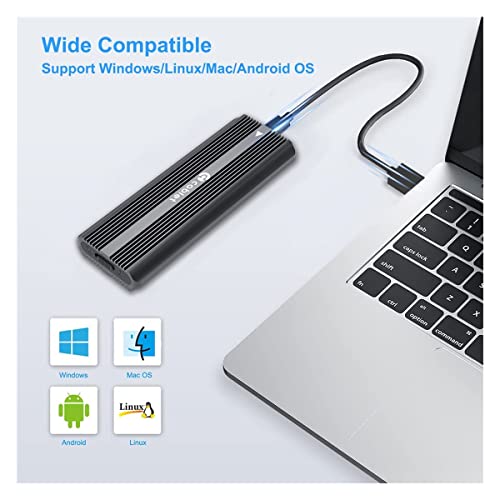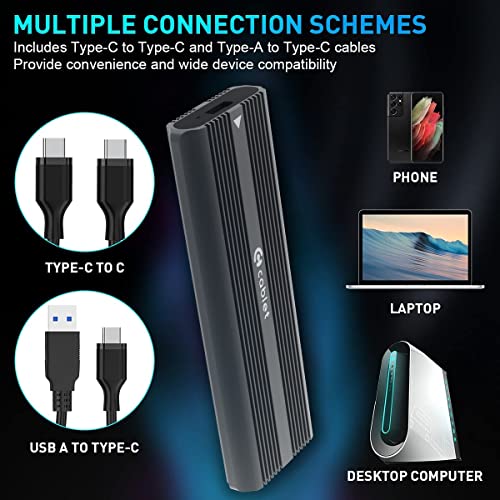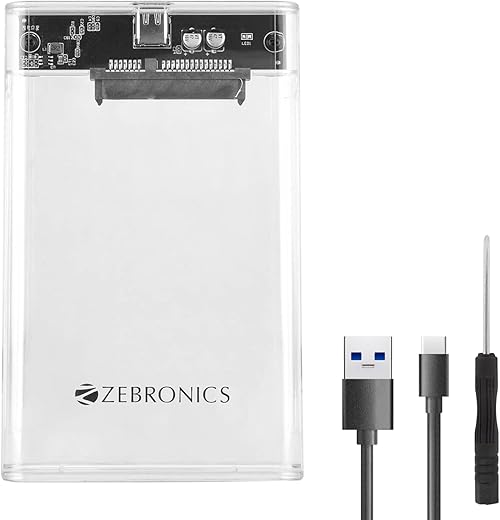Cablet M.2 NVMe SSD Enclosure USB 3.1 Gen2 10Gbps for 2230/2242/2260/2280 M-Key PCIe SSD, Supports UASP Max 2TB, Tool Free Design (SSD Not Included)
₹1,094.00
- Up to 10Gbps with UASP : Cablet M.2 NVMe SSD Enclosure adopts RealTek control chip, with UASP acceleration protocol and USB3.1 Gen2 Type-C output interface, reach up to 900+ MB/S read and write speed.
- M.2 NVMe SSD Enclosure : Compatible with 2230/2242/2260/2280 M-Key PCIe SSD up to 2TB such as Samsung 970 EVO Plus / 970 EVO / 970 Pro / 960 EVO, etc. New SSD drive should be formatted before first time using.
- Compatibility : Supports Windows / Mac / Linux. The M.2 NVMe SSD Enclosure is suitable for connecting PC, smart phone, notebook, computer, smart TV, router, PS4 and other devices. Plug and play, no driver needed. Package include 2 cables (USB-C To USB-C and USB-A To USB-C). Light weight and compact size makes it easy to carry and use.
- Excellent Heat Dissipation : The copper bars with holes on the PCBA board rapidly radiating heat from internal SSD to external ABS and Aluminium case. The external case with heat exchange fin, for better heat dissipation under high-speed transmission.
- Auto Sleep and LED Indicator : 10-minute smart sleep, effectively improves SSD speed, protects data operation, and prolongs SSD life. LED lights at any time monitor work status.
,

Cablet M.2 NVMe SSD Enclosure USB 3.1 Gen2 10Gbps for 2230/2242/2260/2280 M-Key PCIe SSD, Supports UASP Max 2TB, Tool Free Design (SSD Not Included)
₹1,094.00













Not your average reviewer –
Product is good, working perfectly fine. No issues. Read write speed also as expected. only one improvement, not a complain. they could have thought of providing a screw mount for SSD rather than a rubber lock, Rest all is fine.
Not your average reviewer –
I got this for 1199 INR and it’s pretty awesome for the price. The packaging is a clone of Orico NVMe enclosures with the branding changed to “cablet” but I don’t care about that. The outer shell is made of aluminum and works very well in keeping the SSD cool and wicks away a lot of heat and becomes quite hot if you touch it while the enclosure is plugged in and functioning. My Gen 4 XPG SSD didn’t reach temperatures over 55 degrees Celsius during my tests.
The inner part is made of plastic and feels quite cheap. The PCB is attached to this plastic using two little screws and since they screw into plastic, the threads are easy to ruin making it so you can never screw it in again. In fact, one of the screws on my unit was already messed up when it arrived without me ever unscrewing it.
Also, if you’re trying to attach a NVMe SSD that has an attached heat sink, the it’s quite a tight fit and you can easily scratch the heat sink on the NVMe SSD.
For build quality, I’d rate this a 3/5 because of the screws going into plastic
The USB bridge controller used in the enclosure is a JMicron JMS583 (A3 hardware revision) which is the latest revision of the JMS583 chip so that’s great. It also came with firmware v02.01.04 built on 2023-06-24 so that’s awesome too as it’s the latest version available so far AFAIK. The enclosure also has an onboard flash chip made by PUYA so you can dump and update the firmware on this enclosure if you wish to do so.
Coming to performance and stability issues, I didn’t notice any. I used it with a Samsung SSD 980 1TB and XPG Gammix S70 Blade 2TB. The Samsung is a PCIe Gen 3 SSD while the XPG is a PCIe Gen 4 SSD and both worked flawlessly with this enclosure. I tested it on a MSI GE75 9SG laptop.
Obviously, you won’t get the full native read/write speeds from the SSD when using it over USB but the performance I got was pretty much what I expected. 1000 MB/s sequential read/write speeds. However the more important aspect of this enclosure was that all the synthetic and real-world tests that I did passed! It didn’t fail or disconnect when writing or reading small files which is a big deal if you’ve used other NVMe enclosures and have encountered stability issues where it disconnects randomly during real-world or synthetic benchmark runs. No such issues with this enclosure.
All things considered, I think this enclosure is a 5/5.
I wish the plastic used was of better quality so the screws didn’t become useless after unscrewing them a few times but other than that, it does its jobs quite well.
RvidD –
My friend recommended to get the Orico one, but that one is over priced. Got it for 1200 and its working like a charm. Had heat sink sticker with it. Two cables type c to type c and usb to type c are included. (Initially received a defective piece, and got that replaced)
RvidD –
Product is awesome, Very sturdy.
I bought it around 1200.
Con: silicon heat pad size is too small, also ssd locking system is made of rubber it must be screw.
Now the seller increase price at 1999, according me prize should be under 1500.
Troid –
It comes with heat spreader sticker and heavy metal enclosure to prevent the die from overheating. So it easily dissipates excessive heat!
It also comes with an extra SSD holding rubber and 2 USB cables (C-C & C-A) which is fantastic for this price!
So there is absolutely no reason to consider other SSD enclosures when this ₹1200 device does the job perfectly!!
Troid –
I’ve tried various phones but it simply does not work even with 512gb ssd. 2tb ssd was not even detected on the phone, completely ruining the purpose
Mehul –
This is Avery sturdy and good looking enclosure. I would recommend it over Orico’s enclosure. It uses the same controller as Orico but costs Rs. 300 lesser. I am getting close to 1000 mb/s transfer speeds with my Mac mini M2.
Mr Sab. –
I needed more space for my m3 15-inch MacBook air 16 GB RAM variant. 256 gb isn’t enough.
I did a LOT of research, and I was on a budget and was okay with 1 GBps speed. Instead of going for the true external SSDs like Crucial x6 (SATA) or Samsung T7 and the T7 pro, I figured that I could just use an internal NVME SSD paired with an Enclosure and DIY my own external SSD at half the price.
Get the Kioxia Exceria G2 1 TB ( https://amzn.in/d/bUihrqy ) • [I got it for ₹4,499 on 7/3/25]
And pair it with this Cablet Enclosure ( https://amzn.in/d/e1nM1T7 ) • [I got it for ₹1,094 on 7/3/25]
Remember this:
1. Unless you get a 40 Gbps enclosure from Acasis etc. (₹20,000), DON’T get Gen 4.0 nvme drives. Your enclosure will restrict the speed to 10Gbps and on top of that the Gen 4.0 nvme will heat significantly more than Gen 3.0
2. Don’t get QLC drives. Get TLC.
3. Don’t get Crucial P3. Or anything else basically.
4. Don’t get those plastic enclosures. And don’t get the other Cablet enclosure whose videos are all over YouTube. (Don’t buy this https://amzn.in/d/4pcyIAv, as this isn’t as good as the one I bought at heat dissipation).
5. Don’t get SSD with a heatsink for this enclosure. Won’t fit.
The Kioxia Exceria G2 I recommended above, also has a DRAM.
And it makes a world of difference if you’re planning to keep it connected to your Mac for an extended time and basically just use it as the internal SSD, only accessing it occasionally whenever you need it.
(I am not using this setup for dumping massive files in it as backup and throw it in some drawer)
On paper, this SSD isn’t the fastest NVME. But if you’re using a 10Gbps 3.1 gen 2 or 3.2 enclosure (budget ones), for example this “Cablet” one or the ugly PiBox ones, then this SSD will be perfect. It maxes out at 2GBps and will be restricted to 1GBps.
Now heating was a big concern of mine. Luckily, the combo I am recommending here does NOT heat up when idle. This Cablet enclosure got slightly warm on touch when I transferred 70GB from Mac’s internal SSD to the Kioxia G2. But I tried transferring the same file once again with the aluminum case opened, that way I could touch the SSD directly with my bare finger. And boy was it hot. Couldn’t touch it for more than 2 seconds with finger tip. Things got better after I put the thermal pad provided with the enclosure.
I tried with NVME Gen 4.0 SSD as well. No difference in speed, but the heat was EXTREMELY noticeable. Samsung ssd ran cool though.
Conclusion: Just buy the combo I got.
FINALLY, when you connect it to your Mac, it won’t show up in Finder. When you try to “Erase” drive in “Disk utility.app” then it’ll say “The calling process or user lacks the proper privileges to perform this operation”. This is how you’ll fix it –
Step 1: Open “Disk Utility” and initialize
Step 2: Open “System Settings” and give “Full disk access” to “Disk Utility”.
Step 3: Disconnect and reconnect SSD physically.
Step 4: Go back to “Disk Utility” and initialize
Step 5: Erase the disk by setting Format: APFS (or ex-fat if you’ll connect ssd to both windows and mac), Scheme: GUID
Enjoy.